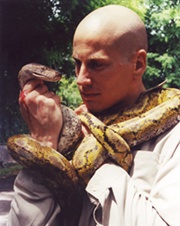Traces of 'relic venom' in python bites misguide diagnosis
16 Apr 2013
A University of Queensland (UQ) researcher has found the potential for Australian doctors to prescribe expensive anti-venom to snake bite victims who don't need it.
UQ School of Biological Sciences associate professor Bryan Grieg Fry and colleagues have published research this week which shows pythons are a surprising potential source of false-positives in snake venom detection kits.
Fry said that although pythons were non-venomous, ''relic'' traces of venom in their saliva could trigger the extremely sensitive snake venom detection kits.
 ''Using antivenom to treat patients with python bite injuries could potentially trigger life-threatening allergies to the antivenom, without the benefit of curing a snake bite,'' he said.
''Using antivenom to treat patients with python bite injuries could potentially trigger life-threatening allergies to the antivenom, without the benefit of curing a snake bite,'' he said.
''Unnecessary use of the anti-venom reduces stocks available for patients who actually need it.''
Fry said this highlighted the decisions about administering anti-venom should be based on the severity of clinical symptoms.
''A venom detection kit should be used to ensure that the appropriate anti-venom is given, but it is sometimes mistakenly used as a diagnosis of snakebite by itself,'' he said.
''All snakes evolved from a common ancestor that was a venomous lizard.''
''Evolution is like a crime scene, there is always evidence to be found if the scientist is a good enough detective.''
According to Fry snakes had varying potency of 'venomosity' ranging from those capable of life-threatening bites, such as cobras or taipans, to those that have lost almost all their venom, such as egg-eating sea snakes and pythons.
Previous studies that found python saliva could cross-react in the snake venom detection kit were dismissed as an anomaly.
Fry's study found that a python's oral glands predominantly secrete mucous to aid in swallowing large prey, but there are also traces of relic venom.
''The extremely low levels of toxins in their mouths have no effect on prey or bitten humans, however in forensic-level diagnostic tools like the snake venom detection kit, they cross-react and give a false positive.''
''These novel molecules represent an untapped resource for biodiscovery,'' Associate Professor Fry said.
''We have found that the low level of ancient toxins still secreted in these glands includes novel compounds quite different than those from their well-studied cousins like rattlesnakes or mambas.''
''In addition to providing insights regarding how the snake venom system evolved, these results reinforce the value of studying a wide range of snakes, as novel compounds with significant potential for use in drug design and development may be uncovered in the most unlikely of places,'' he said.
The study findings are published in Molecular & Cellular Proteomics.













.jpg)






.jpg)









